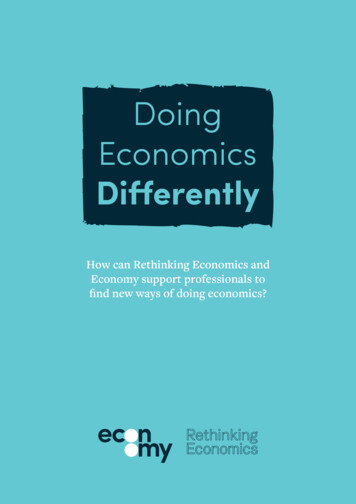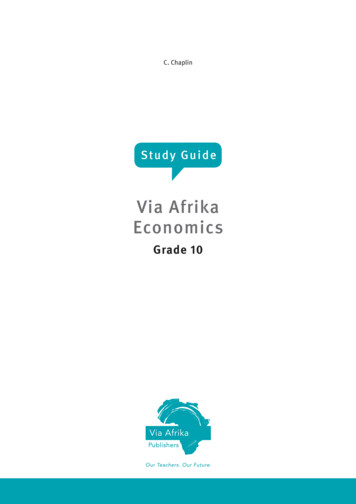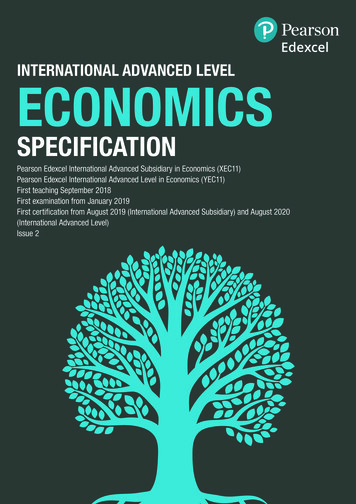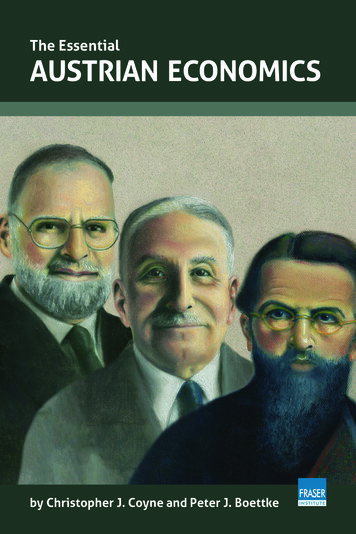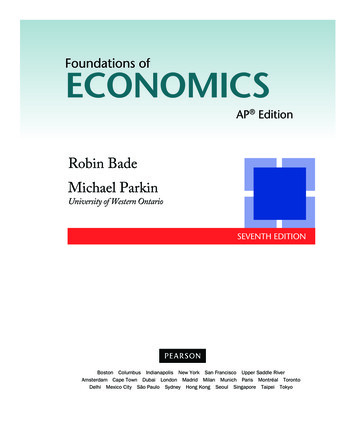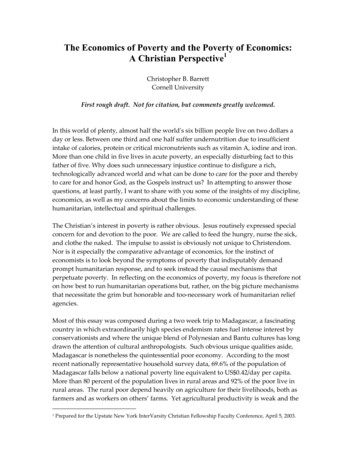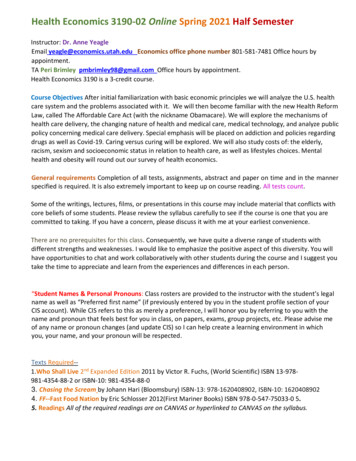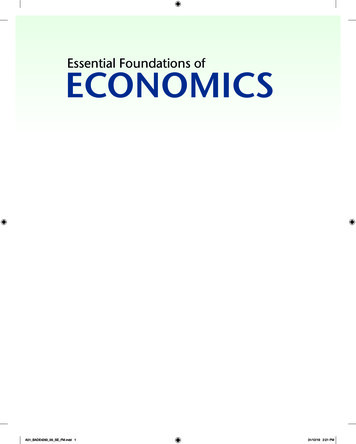
Transcription
Essential Foundations ofECONOMICSA01 BADE4260 09 SE FM.indd 131/12/19 2:21 PM
A01 BADE4260 09 SE FM.indd 231/12/19 2:21 PM
Essential Foundations ofECONOMICSRobin BadeMichael ParkinUniversity of Western OntarioNINTH EDITIONA01 BADE4260 09 SE FM.indd 331/12/19 2:21 PM
Please contact pport with any queries on this content.Copyright 2021, 2018, 2015 by Pearson Education, Inc. or its affiliates, 221 River Street, Hoboken,NJ 07030. All Rights Reserved. Manufactured in the United States of America. This publication isprotected by copyright, and permission should be obtained from the publisher prior to any prohibitedreproduction, storage in a retrieval system, or transmission in any form or by any means, electronic,mechanical, photocopying, recording, or otherwise. For information regarding permissions, requestforms, and the appropriate contacts within the Pearson Education Global Rights and Permissionsdepartment, please visit www.pearsoned.com/permissions/.Acknowledgments of third-party content appear on the appropriate page within the text and on pageC-1, which constitutes an extension of this copyright page.PEARSON, ALWAYS LEARNING, and MYLAB are exclusive trademarks owned by Pearson Education,Inc. or its affiliates in the U.S. and/or other countries.Unless otherwise indicated herein, any third-party trademarks, logos, or icons that may appear inthis work are the property of their respective owners, and any references to third-party trademarks,logos, icons, or other trade dress are for demonstrative or descriptive purposes only. Such referencesare not intended to imply any sponsorship, endorsement, authorization, or promotion of Pearson’sproducts by the owners of such marks, or any relationship between the owner and Pearson Education,Inc., or its affiliates, authors, licensees, or distributors.Library of Congress Cataloging-in-Publication DataNames: Bade, Robin, author. Parkin, Michael, author.Title: Foundations of economics / Robin Bade, Michael Parkin, University ofWestern Ontario.Description: Ninth edition. New York, NY : Pearson, [2021] Includesindex.Identifiers: LCCN 2019050192 (print) LCCN 2019050193 (ebook) ISBN9780135917725 (paperback) ISBN 9780135894019 (paperback) ISBN9780135814260 (paperback) ISBN 9780135896952 (epub)Subjects: LCSH: Economics.Classification: LCC HB171.5 .B155 2021 (print) LCC HB171.5 (ebook) DDC 330—dc23LC record available at https://lccn.loc.gov/2019050192LC ebook record available at CodeISBN 10: 0-13-581426-XISBN 13: 978-0-13-581426-0A01 BADE4260 09 SE FM.indd 431/12/19 2:21 PM
vTo Erin, Tessa, Jack, Abby, and SophieA01 BADE4260 09 SE FM.indd 531/12/19 2:21 PM
A01 BADE4260 09 SE FM.indd 631/12/19 2:21 PM
viiAbout the AuthorsRobin Bade was an undergraduate at the University of Queensland,Australia, where she earned degrees in mathematics and economics. After a spellteaching high school math and physics, she enrolled in the Ph.D. program atthe Australian National University, from which she graduated in 1970. She hasheld faculty appointments at the University of Edinburgh in Scotland, at Bond University in Australia, and at the Universities of Manitoba, Toronto, and Western Ontario in Canada. Her research on international capital flows appears in theInternational Economic Review and the Economic Record.Robin first taught the principles of economics course in 1970 and has taughtit (alongside intermediate macroeconomics and international trade and finance)most years since then. She developed many of the ideas found in this text whileconducting tutorials with her students at the University of Western Ontario.Michael Parkinstudied economics in England and began his niversity teaching career immediately after graduating with a B.A. from theuUniversity of Leicester. He learned the subject on the job at the University of Essex, England’s most exciting new university of the 1960s, and at the age of30 became one of the youngest full professors. He is a past president of theCanadian Economics Association and has served on the editorial boards of theAmerican Economic Review and the Journal of Monetary Economics. His research onmacroeconomics, monetary economics, and international economics has resultedin more than 160 publications in journals and edited volumes, including theAmerican Economic Review, the Journal of Political Economy, the Review of EconomicStudies, the Journal of Monetary Economics, and the Journal of Money, Credit, andBanking. He is author of the best-selling textbook, Economics (Pearson), now in itsThirteenth Edition.Robin and Michael are a wife-and-husband team. Their most notable jointr esearch created the Bade-Parkin Index of central bank independence andspawned a vast amount of research on that topic. They don’t claim credit forthe independence of the new European Central Bank, but its constitution andthe movement toward greater independence of central banks around the worldwere aided by their pioneering work. Their joint textbooks include Macroeconomics (Prentice Hall), Modern Macroeconomics (Pearson Education Canada), andEconomics: Canada in the Global Environment, the Canadian adaptation of Parkin,Economics (Pearson). They are dedicated to the challenge of explaining economics ever more clearly to a growing body of students.Music, the theater, art, walking on the beach, and five grandchildren provides their relaxation and fun.viiA01 BADE4260 09 SE FM.indd 731/12/19 2:21 PM
A01 BADE4260 09 SE FM.indd 831/12/19 2:21 PM
ECONOMICSixBrief ContentsPART 1INTRODUCTION1 Getting Started 12 The U.S. and Global Economies 353 The Economic Problem 614 Demand and Supply 85PART 2A CLOSER LOOK AT MARKETS5 Elasticities of Demand and Supply 1156 Efficiency and Fairness of Markets 1417 Government Actions in Markets 1718 Global Markets in Action 1999 Externalities: Pollution, Education, andHealthcare 229PART 3PRICES, PROFITS, AND INDUSTRY PERFORMANCE10 Production and Cost 25511 Perfect Competition 28312 Monopoly 31113 Monopolistic Competition and Oligopoly 343PART 4MONITORING THE MACROECONOMY14 GDP: A Measure of Total Productionand Income 37315 Jobs and Unemployment 40316 The CPI and the Cost of Living 425ixA01 BADE4260 09 SE FM.indd 931/12/19 2:21 PM
xBRIEF CONTENTSPART 5UNDERSTANDING THE MACROECONOMY17 Potential GDP and Economic Growth 44918 Money and Inflation 48519 Aggregate Supply and Aggregate Demand 51520 Fiscal Policy and Monetary Policy 541Glossary G-1Index I-1Credits C-1A01 BADE4260 09 SE FM.indd 1031/12/19 2:21 PM
xiContentsPA R T 11Getting Started 1Interpreting Graphs Used in Economic Models 28The Slope of a Relationship 31Relationships Among More Than Two Variables 32CHAPTER CHECKLISTAPPENDIX CHECKPOINTCHAPTER1.1IN T RO DU C T ION1Definition and Questions EYE on the BENEFIT AND COST OF SCHOOL2Did You Make the Right Decision?Scarcity 2Economics Defined 2What, How, and For Whom? 3Can the Pursuit of Self-Interest Be in the Social I nterest? 4CHECKPOINT 1.11.2The Economic Way of ThinkingCHECKPOINT 1.2Your Time AllocationAdam Smith and the Birth of Economics as a SocialScience 20CHAPTERCHAPTER CHECKLIST2.1Economics as a Social Science 14Economics as a Policy Tool 152.2CHAPTER SUMMARYCHAPTER CHECKPOINT22Appendix: Making and Using Graphs 25Basic Idea 25Interpreting Data Graphs26The Global Economy 43CHECKPOINT 2.22.3214142The People 43The Economies 43What in the Global Economy 44How in the Global Economy 46For Whom in the Global Economy16Jobs for an Economics Major 16Will the Number of Economics Jobs Grow? 17How Much Do Economics Majors Earn? 17Skills Needed for Economics Jobs 17Economics for Life 1820What, How, and for Whom? 36CHECKPOINT 2.11535What Do We Produce? 36How Do We Produce? 38For Whom Do We Produce?1.3 Economics as a Social Science and PolicyTool 14CHECKPOINT 1.42The U.S. and Global Economies 35101.4 Economics as a Life Skill and Job Skill19 EYE on the PAST813CHECKPOINT 1.312 EYE on YOUR LIFE7A Choice Is a Tradeoff 8Cost: What You Must Give Up 8Benefit: What You Gain 9Rational Choice 9How Much? Choosing at the MarginChoices Respond to Incentives 11344649The Circular Flows 50Households and Firms 50Markets 50Real Flows and Money Flows 50Governments 52Governments in the Circular Flow 53Circular Flows in the Global Economy 54CHECKPOINT 2.356xiA01 BADE4260 09 SE FM.indd 1131/12/19 2:21 PM
xiiCONTENTSCHAPTER SUMMARYCHAPTER CHECKPOINT57CHAPTER CHECKPOINT58 EYE on YOUR LIFEYour Production Possibilities Frontier EYE on the U.S. ECONOMYWhat We Produce82 EYE on the ENVIRONMENT37Is Wind Power Free? EYE on the PAST70 EYE on the U.S. ECONOMYChanges in What We Produce 38Expanding Our Production Possibilities 73 EYE on the U.S. ECONOMY EYE on the GLOBAL ECONOMYChanges in How We Produce in the InformationEconomy 40Hong Kong’s Rapid Economic Growth74 EYE on the U.S. ECONOMY EYE on the DREAMLINERNo One Knows How to Make a PencilWho Makes the Dreamliner? 4575 EYE on YOUR LIFE EYE on the GLOBAL ECONOMYDifferences in How We Produce66Your Comparative Advantage4779 EYE on YOUR LIFEThe U.S. and Global Economies in Your Life49 EYE on the PASTGrowing GovernmentCHAPTER EYE on the GLOBAL ECONOMYThe Ups and Downs in International Trade4Demand and Supply 8554CHAPTER CHECKLIST5685Competitive Markets 86CHAPTER34.1The Law of Demand 87Demand Schedule and Demand Curve 87Individual Demand and Market Demand 89Changes in Demand 90Change in Quantity Demanded Versus Change in Demand 92The Economic Problem 61CHAPTER CHECKLIST3.161Production Possibilities 62Production Possibilities Frontier 62How the PPF Illustrates Scarcity and Its Consequences 63CHECKPOINT 3.13.267CHECKPOINT 4.14.2The Opportunity Cost of a Smartphone 68Opportunity Cost and the Slope of the PPF 69Opportunity Cost Is a Ratio 69Increasing Opportunity Costs Are Everywhere 70Your Increasing Opportunity Cost 703.3Economic Growth 72CHECKPOINT 3.33.47174Specialization and Trade 75Absolute Advantage and Comparative Advantage 75Comparative Advantage: A Model 76Achieving Gains from Trade 78The Economy’s Production Possibilities Frontier 79CHECKPOINT 3.4CHAPTER SUMMARYA01 BADE4260 09 SE FM.indd 12818093Supply 94The Law of Supply 94Supply Schedule and Supply Curve 94Individual Supply and Market Supply 96Changes in Supply 97Change in Quantity Supplied Versus Change in Supply 99Opportunity Cost 68CHECKPOINT 3.2Demand 87CHECKPOINT 4.24.3101Market Equilibrium 102Price: A Market’s Automatic Regulator 102Predicting Price Changes: Three Questions 103Effects of Changes in Demand 104Effects of Changes in Supply 106Effects of Changes in Both Demand andSupply 108CHECKPOINT 4.3CHAPTER SUMMARYCHAPTER CHECKPOINT11011111231/12/19 2:21 PM
CONTENTS EYE on YOUR LIFE EYE on the PRICE OF AVOCADOSUnderstanding and Using Demand and Supply 100Why Does the Price of Avocados Fluctuate?xiii107 EYE on the GLOBAL ECONOMYThe Markets for Cocoa and ChocolatePA R T 2CHAPTER5.1105A C LO S E R LO OK AT M A R K E T S5CHAPTERElasticities of Demandand Supply 115Efficiency and Fairnessof Markets 141CHAPTER CHECKLISTCHAPTER CHECKLIST115The Price Elasticity of Demand 116Percentage Change in Price 116Percentage Change in Quantity Demanded 117Comparing the Percentage Changes in Priceand Quantity 117Elastic and Inelastic Demand 118Influences on the Price Elasticity of Demand 118Computing the Price Elasticity of Demand 120Interpreting the Price Elasticity of Demand Number 121Elasticity Along a Linear Demand Curve 122Total Revenue and the Price Elasticity of Demand 124CHECKPOINT 5.15.2The Price Elasticity of Supply 128CHECKPOINT 5.26.16.2CHAPTER CHECKPOINT137138 EYE on the GLOBAL ECONOMYValue, Price, and Consumer Surplus 150CHECKPOINT 6.26.3Cost, Price, and Producer Surplus 153CHECKPOINT 6.36.4153155Are Markets Efficient? 156Marginal Benefit Equals Marginal CostTotal Surplus Is Maximized 157The Invisible Hand 157Market Failure 159Sources of Market Failure 160Alternatives to the Market 161CHECKPOINT 6.46.5156163Are Markets Fair? 164It’s Not Fair If the Rules Aren’t Fair 164It’s Not Fair If the Result Isn’t Fair 164Compromise 165CHECKPOINT 6.5Price Elasticities of Demand 123CHAPTER SUMMARY EYE on ELASTICITY AT THE COFFEE SHOPCHAPTER CHECKPOINTWhat Do You Do When Starbucks Raises the Priceof a Latte? 125150152Supply and Marginal CostProducer Surplus 154Cross Elasticity of Demand 133Income Elasticity of Demand 134CHAPTER SUMMARY149Demand and Marginal BenefitConsumer Surplus 151132136Allocation Methods and Efficiency 142CHECKPOINT 6.1Cross Elasticity and Income Elasticity 133CHECKPOINT 5.3141Resource Allocation Methods 142Using Resources Efficiently 145127Elastic and Inelastic Supply 128Influences on the Price Elasticity of Supply 128Computing the Price Elasticity of Supply 1305.36166167168 EYE on the U.S. ECONOMY EYE on the U.S. ECONOMYThe Invisible Hand and e-CommerceTwo Applications of the Price Elasticity ofDemand 126 EYE on TICKET SCALPINGShould Ticket Scalping Be Illegal? 162 EYE on YOUR LIFE EYE on YOUR LIFEYour Price Elasticities of Demand 135Allocation Methods, Efficiency, and Fairness 165A01 BADE4260 09 SE FM.indd 1315831/12/19 2:21 PM
xivCONTENTSCHAPTER7CHAPTERGovernment Actionsin Markets 171CHAPTER CHECKLIST7.17.28.1177CHECKPOINT 8.28.3208International Trade RestrictionsCHECKPOINT 8.38.4224225CHAPTER CHECKPOINT191194218219Three Traditional Arguments for Protection 219Four Newer Arguments for Protection 221Why Is International Trade Restricted? 222CHAPTER SUMMARY226 EYE on the U.S. ECONOMYU.S. Exports and Imports 201195 EYE on GLOBALIZATION196 EYE on the U.S. ECONOMYWho Wins and Who Loses fromGlobalization? 205The Federal Minimum Wage 187 EYE on the PAST EYE on PRICE REGULATIONThe History of U.S. Tariffs 209Can Government Repeal the Law of MarketForces? 189 EYE on the U.S. ECONOMY EYE on the GLOBAL ECONOMY EYE on the U.S. ECONOMYProduction QuotasA Tariff on Softwood Lumber191A01 BADE4260 09 SE FM.indd 14213An Import Quota on Sugar 217 EYE on YOUR LIFEPrice Ceilings and Price Floors You Encounter209The Case Against ProtectionCHECKPOINT 8.4190Production QuotasCHAPTER CHECKPOINT204Tariffs 209Import Quotas 214Other Import Barriers 216Export Subsidies 216184The Minimum Wage 185Is the Minimum Wage Efficient? 188Is the Minimum Wage Fair? 189If the Minimum Wage Is So Bad, Why Do WeHave It? 189CHAPTER SUMMARY200International Trade Today 200What Drives International Trade? 200Why the United States Imports T-Shirts 202Why the United States Exports Airplanes 2038.2 Winners, Losers, and Net Gains FromTrade 205Price FloorsCHECKPOINT 7.4How Global Markets WorkCHECKPOINT 8.1183191Production Quota: An Example199Gains and Losses from Imports 206Gains and Losses from Exports 207Price Ceilings 178A Rent Ceiling 178Are Rent Ceilings Efficient? 181Are Rent Ceilings Fair? 182If Rent Ceilings Are So Bad, Why Do We HaveThem? 182CHECKPOINT 7.37.4171172Tax Incidence 172Taxes and Efficiency 173Incidence, Inefficiency, and Elasticity 174Incidence, Inefficiency, and the Elasticity of Demand 175Incidence, Inefficiency, and the Elasticity ofSupply 176CHECKPOINT 7.27.3CHAPTER CHECKLISTTaxes on Buyers and SellersCHECKPOINT 7.18Global Markets in Action 199193 EYE on YOUR LIFEInternational Trade 22331/12/19 2:21 PM
CONTENTSCHAPTER9Externalities: Pollution, Education,and Healthcare 229CHAPTER CHECKLIST229Externalities in our Daily Lives230Negative Production Externalities 230Positive Production Externalities 230Negative Consumption Externalities 231Positive Consumption Externalities 2319.1Negative Externalities: Pollution232Private Costs and Social Costs 232Production and Pollution: How Much? 234Establish Property Rights 235Command-and-Control Regulation 237Pollution Taxes 237CHECKPOINT 9.1PA R T 3CHAPTER2429.2 Positive Externalities: Educationand Healthcare 243Private Benefits and Social Benefits 243Government Actions in the Face of ExternalBenefits 245Economic Problems in Healthcare Markets 248CHECKPOINT 9.2CHAPTER SUMMARY250251CHAPTER CHECKPOINT252 EYE on YOUR LIFEExternalities in Your Life 231 EYE on the U.S. ECONOMYU.S. Air Pollution Trends 239 EYE on CLIMATE CHANGEHow Can We Limit Carbon Emissions?240 EYE on the U.S. ECONOMYHealthcare in the United States: A Snapshot 248P RIC E S , P RO F I T S , A N D I N D US TRY PE R FOR M A NC E10Shifts in the Cost CurvesProduction and CostCHAPTER CHECKLIST25525510.1 Economic Cost and ProfitThe Firm’s Goal 256Accounting Cost and ProfitOpportunity Cost 256Economic Profit 257CHECKPOINT 10.125625610.3 Short-Run Cost275Plant Size and Cost 275The Long-Run Average Cost CurveCHECKPOINT 10.4276278279280 EYE on YOUR LIFE260261Total Product 261Marginal Product 262Average Product 264CHECKPOINT 10.227227410.4 Long-Run CostCHAPTER SUMMARY25910.2 Short-Run ProductionCHECKPOINT 10.3CHAPTER CHECKPOINTShort Run and Long Run266267Total Cost 267Marginal Cost 268Average Cost 269Why the Average Total Cost Curve IsU-Shaped 271Cost Curves and Product Curves 272A01 BADE4260 09 SE FM.indd 15xvYour Average and Marginal Grades 265 EYE on RETAILERS’ COSTSWhich Store Has the Lower Costs: Walmart or7-Eleven? 277CHAPTER11Perfect CompetitionCHAPTER CHECKLIST283283Market Types284Perfect Competition 284Other Market Types 28431/12/19 2:21 PM
xviCONTENTS11.1 A Firm’s Profit-Maximizing ChoicesPrice Taker 285Revenue Concepts 285Profit-Maximizing Output 286Marginal Analysis and the Supply DecisionTemporary Shutdown Decision 289The Firm’s Short-Run Supply Curve 290CHECKPOINT 11.1285CHECKPOINT 12.1288Output and Price 321Is Monopoly Efficient? 322Is Monopoly Fair? 323Rent Seeking 323CHECKPOINT 12.3297326Price Discrimination and ConsumerSurplus 326Profiting by Price Discriminating 327Perfect Price Discrimination 328Price Discrimination and Efficiency 330Entry and Exit 299The Effects of Exit 300Change in Demand 301Technological Change 301Is Perfect Competition Efficient? 304Is Perfect Competition Fair? 305CHECKPOINT 12.433112.5 Monopoly Regulation332Efficient Regulation of a NaturalMonopoly 332Second-Best Regulation of a NaturalMonopoly 333306307308 Eye on Record StoresWhere Have All the Record Stores Gone?32512.4 Price Discrimination11.3 Output, Price, and Profit in the LongRun 298CHAPTER CHECKPOINT32012.3 Monopoly and CompetitionCompared 321Market Supply in the Short Run 293Short-Run Equilibrium in Normal Times 294Short-Run Equilibrium in Good Times 295Short-Run Equilibrium in Bad Times 296CHAPTER SUMMARY316Price and Marginal Revenue 316Marginal Revenue and Elasticity 317Output and Price Decision 318CHECKPOINT 12.211.2 Output, Price, and Profit in the ShortRun 293CHECKPOINT 11.331512.2 Single-Price Monopoly292CHECKPOINT 11.2Monopoly Price-Setting Strategies 314CHECKPOINT 12.5302CHAPTER SUMMARY EYE on YOUR LIFEThe Perfect Competition That You Encounter305338339CHAPTER CHECKPOINT340 EYE on the U.S. ECONOMYCHAPTERInformation-Age Monopolies12 EYE on the U.S. ECONOMYMonopoly 311CHAPTER CHECKLISTAirline Price DiscriminationA01 BADE4260 09 SE FM.indd 16330 EYE on MICROSOFT31112.1 Monopoly and How it ArisesNo Close Substitute 312Barrier to Entry 312314Are Microsoft’s Prices Too High?312335 EYE on YOUR LIFEMonopoly in Your Everyday Life 33631/12/19 2:21 PM
CONTENTSCHAPTER13The Duopolists’ Dilemma 358CHECKPOINT 13.3Monopolistic Competition andOligopoly 343CHAPTER CHECKLIST361What Is a Game? 361The Prisoners’ Dilemma 361The Duopolists’ Dilemma 363Advertising and Research Games in OligopolyRepeated Games 366Is Oligopoly Efficient? 367343Describing Monopolistic Competition 344Identifying Monopolistic Competition 345Output and Price in Monopolistic CompetitionMonopolistic Competition and PerfectCompetition 349347351Design and Quality Decisions 351Advertising 351The Demand for Advertising 352The Supply of Advertising 353Equilibrium and Efficiency in the AdvertisingMarket 354355PA R T 4CHAPTER368369370 EYE on the U.S. ECONOMYExamples of Monopolistic Competition346 EYE on SMARTPHONESWhich Smartphone?353 EYE on YOUR LIFESome Selling Costs You Pay354 EYE on YOUR LIFE EYE on the WIRELESS OLIGOPOLYWhich Wireless Service?357367M O NI TO RING TH E M ACROE CONOM Y14Expenditure Equals IncomeGDP: A Measure of Total Productionand Income 373CHAPTER CHECKLIST37314.1 GDP, Income, and ExpenditureGDP Defined 374Circular Flows in the U.S. EconomyA01 BADE4260 09 SE FM.indd 17CHAPTER SUMMARY364A Game You Might Play 36613.3 Oligopoly356Collusion 356Duopoly in AirplanesCHECKPOINT 13.4CHAPTER CHECKPOINT35013.2 Innovation and AdvertisingCHECKPOINT 13.236013.4 Game Theory13.1 Monopolistic Competition: output andprice 344CHECKPOINT 13.1xvii374375CHECKPOINT 14.137637814.2 Measuring U.S. GDP379The Expenditure Approach 379The Income Approach 381GDP and Related Measures of Productionand Income 383Real GDP and Nominal GDP 384Calculating Real GDP 38431/12/19 2:21 PM
xviiiCONTENTSUsing the Real GDP NumbersCHECKPOINT 14.238538614.3 The Uses and Limitations of RealGDP 387The Standard of Living Over Time 387Tracking the Course of the Business Cycle 388The Standard of Living Among Countries 390Goods and Services Omitted from GDP 391Other Influences on the Standard of Living 392CHECKPOINT 14.3CHAPTER SUMMARY394Appendix: Measuring Real GDP 399The Problem With Base Year Prices 399Value Production in the Prices of AdjacentYears 399402 EYE on the U.S. ECONOMYIs a Computer Program an Intermediate Goodor a Final Good? 380 EYE on BOOMS AND BUSTSHow Do We Track Economic Booms andBusts? 390 EYE on YOUR LIFEMaking GDP Personal392 EYE on the GLOBAL ECONOMYWhich Country Has the Highest Standardof Living? 393A01 BADE4260 09 SE FM.indd 18CHAPTER CHECKLIST40340315.1 Labor Market Indicators404Current Population Survey 404Population Survey Criteria 404Three Labor Market Indicators 405Alternative Measures of Unemployment40640815.2 Labor Market Trends andFluctuations 409396APPENDIX CHECKPOINT15CHECKPOINT 15.1395CHAPTER CHECKPOINTCHAPTERJobs and UnemploymentThe Unemployment Rate 409The Participation Rate 410Alternative Measures of UnemploymentCHECKPOINT 15.241241315.3 Unemployment and FullEmployment 414Frictional Unemployment 414Structural Unemployment 414Cyclical Unemployment 415“Natural” Unemployment 415Unemployment and Real GDP 417CHECKPOINT 15.3CHAPTER SUMMARY420421CHAPTER CHECKPOINT422 EYE on the U.S. ECONOMYThe Current Population Survey40731/12/19 2:21 PM
CONTENTS EYE on the GLOBAL ECONOMYAlternative Consumer Price IndexesUnemployment and Labor Force Participation411 EYE on the U.S. ECONOMYHow Long Does It Take to Find a Job?438Dollars and Cents at Different Dates 438Nominal and Real Values inMacroeconomics 439Nominal GDP and Real GDP 439Nominal Wage Rate and Real Wage Rate 440Nominal Interest Rate and Real InterestRate 442416 EYE on YOUR LIFEYour Labor Market Status and ActivityCHAPTER16419CHECKPOINT 16.3The CPI and the Cost of LivingCHAPTER CHECKLIST42542516.1 The Consumer Price Index42643116.2 The CPI and Other Price LevelMeasures 432Sources of Bias in the CPI 432The Magnitude of the Bias 433Two Consequences of the CPI BiasA01 BADE4260 09 SE FM.indd 19CHAPTER SUMMARY434444445CHAPTER CHECKPOINTReading the CPI Numbers 426Constructing the CPI 426The CPI Market Basket 426The Monthly Price Survey 427Calculating the CPI 428Measuring Inflation and Deflation 429The Price Level, Inflation, and Deflation in the UnitedStates 429CHECKPOINT 16.143443716.3 Nominal and Real Values415 EYE on FULL EMPLOYMENTAre We at Full Employment?CHECKPOINT 16.2xix446 EYE on the PAST700 Years of Inflation and Deflation430 EYE on the U.S. ECONOMYMeasuring and Forecasting Inflation: The Sticky-PriceCPI 436 EYE on the U.S. ECONOMYDeflating the GDP Balloon 439 EYE on the PASTThe Nominal and Real Wage Rates of Presidents of theUnited States 441 EYE on BOX OFFICE HITSWhich Movie Really Was the Biggest Box OfficeHit? 442 EYE on YOUR LIFEA Student’s CPI 44331/12/19 2:21 PM
xxCONTENTSPA R T 5CHAPTERU NDE RS TAN DING TH E M ACROE CONOM Y17 EYE on the U.S. ECONOMYPotential GDP and EconomicGrowth 449CHAPTER CHECKLIST449Macroeconomic Approaches and Pathways 450The Three Main Schools of ThoughtToday’s Consensus 451The Road Ahead 452450CHECKPOINT 17.1U.S. Labor Productivity Growth Since 1960 470460462475476Preconditions for Economic Growth 476Policies to Achieve Faster Growth 477How Much Difference Can Policy Make? 478CHECKPOINT 17.4CHAPTER SUMMARY481CHAPTER CHECKPOINTA01 BADE4260 09 SE FM.indd 20480482 EYE on the U.S. ECONOMYThe Changing Shares in the Gains from EconomicGrowth 473 EYE on YOUR LIFE464Labor Productivity 464Saving and Investment in Physical Capital 464Expansion of Human Capital and Discovery of NewTechnologies 466Combined Influences Bring Labor ProductivityGrowth 468What Keeps Labor Productivity Growing? 471Economic Growth and the Distribution of Income 47217.4 Achieving Faster Growth461 EYE on the U.S. ECONOMY463CHECKPOINT 17.3Why Do Americans Earn More and Produce More ThanEuropeans? 458U.S. Growth Is Slowing 46217.2 The Basics of Economic Growth17.3 Labor Productivity Growth EYE on the U.S. ECONOMY EYE on the U.S. ECONOMY459CHECKPOINT 17.2Potential GDP in the United States and EuropeanUnion 453How Fast Has Real GDP per Person Grown?454Calculating Growth Rates 460The Magic of Sustained Growth EYE on the GLOBAL ECONOMY EYE on the PAST17.1 Potential GDP453The Production FunctionThe Labor Market 455The Lucas Wedge and the Okun Gap 452How You Influence and Are Influenced by EconomicGrowth 474 EYE on RICH AND POOR NATIONSWhy Are Some Nations Rich and Others Poor?CHAPTER47918Money and Inflation 485CHAPTER CHECKLIST48518.1 What is Money?486Definition of Money 486The Functions of Money 486Money Today 488Official Measures of Money: M1 and M2 488Checks, Credit Cards, Debit Cards, and MobileWallets 48931/12/19 2:21 PM
CONTENTSAn Embryonic New Money: E-CashCHECKPOINT 18.149049118.2 The Banking System492Commercial Banks 492Thrift Institutions 494Money Market Funds 494The Federal Reserve System 495The Structure of the Federal Reserve 495The Fed’s Policy Tools 496How the Fed’s Policy Tools Work 497CHECKPOINT 18.249818.3 Regulating the Quantity of Money499Creating Deposits by Making Loans 499How Open Market Operations Change the MonetaryBase 501The Multiplier Effect of an Open MarketOperation 502The Money Multiplier 503CHECKPOINT 18.350618.4 Money, the price level, and inflation507The Velocity of Circulation and Equation of Exchange 507CHECKPOINT 18.4CHAPTER SUMMARY51019Aggregate Supply and AggregateDemand 515CHAPTER CHECKLIST512516Aggregate Supply Basics 516Changes in Aggregate Supply 519CHECKPOINT 19.152119.2 Aggregate Demand522Aggregate Demand Basics 522Changes in Aggregate Demand 524The Aggregate Demand Multiplier 526CHECKPOINT 19.252719.3 Explaining Economic Trends andFluctuations 528Macroeconomic Equilibrium 528Three Types of Macroeconomic Equilibrium 529Economic Growth and Inflation Trends 530The Business Cycle 531Inflation Cycles 532Deflation and the Great Depression 534CHAPTER SUMMARY536537CHAPTER CHECKPOINT EYE on YOUR LIFE51519.1 Aggregate SupplyCHECKPOINT 19.3511CHAPTER CHECKPOINTCHAPTER538Money and Your Role in Its Creation 499 EYE on the U.S. ECONOMY EYE on CREATING MONEYU.S. Economic Growth, Inflation, and the BusinessCycle 530How Does the Fed Create Money and Regulate ItsQuantity? 504 EYE on YOUR LIFE EYE on the U.S. ECONOMYUsing the AS-AD ModelWhat Causes Inflation? EYE on RECESSION509What Causes a Recession?A01 BADE4260 09 SE FM.indd 21xxi53453531/12/19 2:21 PM
xxiiCONTENTSCHAPTER20Fiscal Policy and MonetaryPolicy 541CHAPTER CHECKLISTMonetary Stabilization in the AS-AD Model 560Limitations of Monetary Stabilization Policy 563CHECKPOINT 20.2CHAPTER SUMMARY541565CHAPTER CHECKPOINT20.1 The Federal Budget and FiscalPolicy 542564566 EYE on the PASTThe Federal Budget 542Budget Balance and Debt 542Cyclical and Structural Budget Balances 545A Fiscal Policy Challenge 546Generational Accounting 546Discretionary Fiscal Policy: Demand-SideEffects 548A Successful Fiscal Stimulus 549Discretionary Fiscal Policy: Supply-SideEffects 550Limitations of Discretionary Fiscal Policy 552Automatic Fiscal Policy 552Schools of Thought and Cracks in Today’sConsensus 553Federal Tax Revenues, Outlays, Deficits, and DebtCHECKPOINT 20.1Fiscal Policy and Monetary Policy and HowThey Affect You 56355520.2 The Federal Reserve and MonetaryPolicy 556The Monetary Policy Process 556The Federal Funds Rate Target 557The Ripple Effects of the Fed’s ActionsA01 BADE4260 09 SE FM.indd 22558544 EYE on the U.S. ECONOMYThe U.S. Structural and Cyclical Budget Balances 545 EYE on the U.S. ECONOMYFiscal and Generational Imbalances547 EYE on the GLOBAL ECONOMYThe U.S. Budget in Global Perspective 553 EYE on FISCAL STIMULUSCan Fiscal Stimulus End a Recession?554 EYE on the FED IN A CRISISDid the Fed Save Us From Another GreatDepression? 562 EYE on YOUR LIFEGlossary G-1Index I-1Credits C-131/12/19 2:21 PM
ESSENTIAL FOUNDATIONS OF ECONOMICSdelivers a complete, hands-on learning system designedaround active learning.A Learning-by-DoingApproachThe Checklist that begins each chapterhighlights the key topics covered and thechapter is divided into sections that directlycorrelate to the Checklist.The Checkpoint that ends each sectionprovides a full page of practice problems toencourage students to review the materialwhile it is fresh in their minds.Each chapter opens with a question abouta central issue that sets the stage for thematerial.Why does the price of avocados fluctuate?4Demand and SupplyCHAPTER CHECKLISTWhen you have completed your study of this chapter,you will be able to1 Distinguish between quantity demanded and demand, and explainwhat determines demand.2 Distinguish between quantity supplied and supply, and explainwhat determines supply.3 Explain how demand and supply determine price and quantity in amarket, and explain the effects of changes in demand and supply.CHECKPOINT 4.1Distinguish between quantity demanded and demand, and ex
Robin Bade Michael Parkin University of Western Ontario Essential Foundations of ECONOMICS NINTH EDITI




